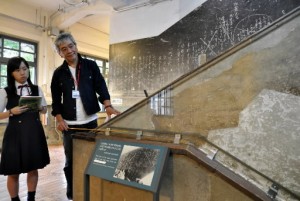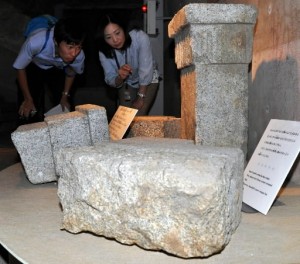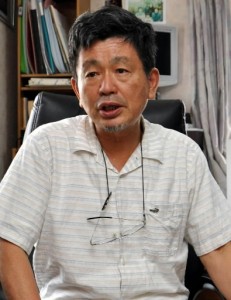Peace Seeds: Hiroshima Teens Report on Peace Issues, Part 9
Sep. 22, 2014
Peace museums at elementary school
Buildings that survived A-bombing tell of its ravages
Located in Naka Ward within 500 meters of the atomic bombing’s hypocenter, both Fukuromachi Elementary School and Honkawa Elementary School have peace museums on their grounds. The two schools were built in the first half of the 20th Century, and portions of their ferroconcrete buildings, which withstood the blast and thermal rays of the A-bombing, have been preserved and put to use as museums. Most of the schoolchildren who remained in the city rather than relocating to rural areas to escape air raids, particularly those in the lower grades of elementary school, lost their lives in the A-bombing. We visited the museums at the two schools, which tell the story of that day.
■Fukuromachi Elementary School
Messages to confirm safety written on wall
Fukuromachi Elementary School is located 460 meters from the hypocenter. Its peace museum is housed in part of the school’s west building, which survived the A-bombing and has been preserved. On one wall of the building are messages that were written after the A-bombing by people who came to the school, which had become an aid station, to confirm the safety of students and local residents.
A study was conducted prior to the rebuilding of the school building in 1999. When plaster was removed from part of the wall, the words “in the dormitory” were found. This led to a full-scale study by experts.
The messages were photographed in October 1945 by the late Shunkichi Kikuchi, a photographer who came to Hiroshima with the Education Ministry’s Special Committee for the Investigation of A-bomb Damage. The photo shows messages written by the school’s teachers and others in chalk on the wall, which had turned black from soot. One said: “August 12. Mr. Kimura [a teacher] came to the school and said to say hello to everyone. Kato.” Because chalk is made of lime, it hardens upon absorbing moisture. Thus the writing on the wall was preserved.
About 140 students were at the school on August 6, 1945. Only the three who were in the basement 3 meters below ground survived. The rest were killed. Only a few seconds made the difference between life and death. The basement has also been preserved.
The school continues to carry out a peace education program so that local children will acquire accurate knowledge and contribute to the effort to bring about peace. Every month the students in one grade clean the school’s museum and nearby Fukuromachi Park, where there is a memorial cenotaph, in an effort to pass history on. Every year students from Nishinomiya in Hyogo Prefecture visit Hiroshima. Sixth graders at Fukuromachi Elementary School show them around the museum and explain the exhibits in their own words.
Eiji Hiramoto, 56, principal of the school, said, “The museum is a witness to the atomic bombing. I’d like people in the neighborhood to stop in and learn about the value of human life.” (Nako Yoshimoto, third-year junior high school student)
■Honkawa Elementary School
Sensing A-bombing by touching artifacts
At a distance of only 410 meters, Honkawa Elementary School was closer to the hypocenter than any other school. The approximately 400 students who were there that day were killed. Opened in 1988, the peace museum makes use of a portion of the original three-story, ferroconcrete structure, the first such school building in the city, which was erected in 1928. The museum exhibits about 60 items that were found on the school grounds such as melted bottles. Some of the items can be touched by visitors, one unique feature of the museum
In 2004, when students of the school began to create a biotope on the school grounds, they found bottles and tiles that had melted from the heat of the A-bombing. Their deformed shapes tell of the intensity of the heat of the A-bombing. “There must be more artifacts of the A-bombing in the schoolyard,” said Miho Iwata, 56, who has served as a guide at the museum for the past 14 years. “I’d like visitors to get a sense of the horrors of nuclear weapons and realize that if these weapons are used again the destruction will be far worse.”
Granite that was part of the balcony of the former Prefectural Industrial Promotion Hall (now the A-bomb Dome) is also on display. It fell off as a result of the shock of the explosion and was recovered from the banks of the Motoyasu River, which runs alongside the building, in 2010 by students from Honkawa Elementary School. When I touched it, the surface, which had been exposed to the A-bomb’s thermal rays, was rough.
The museum also exhibits a panoramic model of the city center just after the A-bombing that used to be displayed at the Peace Memorial Museum. It also houses the stump of an ailanthus tree that sprouted on the school grounds the year after the A-bombing, inspiring dreams and giving people hope. The tree later died. Kazunori Kono, 58, principal of the school, said, “I’d like people to touch these artifacts, sense the cries of the people and think about what they can do to eliminate nuclear weapons.” (Takeshi Iwata, first-year high school student)
Importance of preserving buildings on site An interview with former professor Satoru Ubuki We interviewed Satoru Ubuki, a former professor at Hiroshima Jogakuin University, about the significance of preserving parts of the school buildings at Fukuromachi and Honkawa elementary schools as museums and how they should be used in the future. Prof. Ubuki, 68, a resident of Kure, is an expert on Hiroshima’s postwar history.
Although both schools were within 500 meters of the hypocenter, they remained standing because of their ferroconcrete construction. Both schools lost nearly all of their students and teachers in the A-bombing. “The schools are located near the hypocenter in locations that sustained heavy damage,” Prof. Ubuki said. “The buildings are of value if only because they withstood the A-bombing and survived.”
Because their condition deteriorated through the 1980s and 1990s, it was decided to rebuild the schools. The pleas of former students and local residents who stressed the value of the buildings led to their preservation. The structures could not be preserved in their entirety, but both schools were able to save a portion of their buildings.
Some buildings that survived the A-bombing were moved to different locations and preserved there. But, according to Prof. Ubuki, “It’s important to leave buildings where they were at the time. When you do that, people can exercise their imaginations. We must not forget that such a sad event occurred in Japan, which is thought of as a peaceful nation.” Prof. Ubuki said he was moved when the messages on the wall at Fukuromachi Elementary School were found and it was decided to leave them as they were. They provide an opportunity to understand the chaos experienced by citizens at the time of the A-bombing and their way of life then.
By having peace museums at schools in buildings that survived the A-bombing, the students have opportunities to learn about peace in their daily lives. Prof. Ibuki has proposed including the museums in the routes of tours of A-bomb-related sites in the city and publicizing them overseas so that many people will become aware of the museums’ importance. (Story by Maiko Hanaoka, first-year high school student; photo by Satoko Hirata, second-year high school student)
(Originally published on September 22, 2014)










